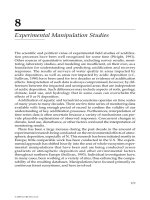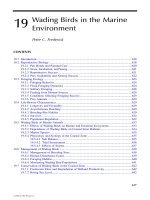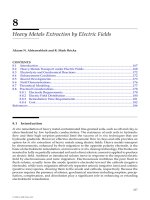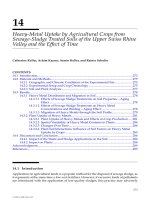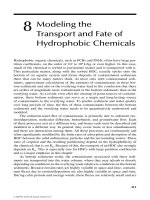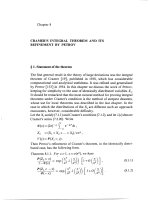Bioremediation of Relcalcitrant Compounds - Chapter 8 (end) pps
Bạn đang xem bản rút gọn của tài liệu. Xem và tải ngay bản đầy đủ của tài liệu tại đây (263.86 KB, 4 trang )
301
chapter eight
Future needs for research
and development
Jeffrey W. Talley
Contents
8.1 Introduction 301
8.2 Polycyclic aromatic hydrocarbons 301
8.3 Chlorinated solvents 303
8.4 Polychlorinated biphenyls 304
8.1 Introduction
During the course of project CU-720, researchers and engineers in Federal
Integrated Biotreatment Research Consortium (FIBRC) conducted basic
research and developed treatment processes, many of which were scaled
up to pilot- or field-scale implementation. In the course of this work, a
number of research and developmental issues were identified as worthy of
following up but were not pursued due to a desire to move the technology
with the most potential to the pilot or field scale. The following issues were
identified in each of the thrust areas as frontiers of science and technology
in bioremediation.
8.2 Polycyclic aromatic hydrocarbons
In theory, soils contaminated with polycyclic aromatic hydrocarbons (PAHs)
may be treated utilizing various cleanup strategies. However, many pro-
posed strategies have significant economic and feasibility problems. What
is needed is an effective technology that supports the economics of disposal,
eliminates adverse contaminant impacts, and supports the reuse of treated
contaminated soils. Regardless of whether the biotreatment system is passive
L1656_C008.fm Page 301 Monday, June 20, 2005 1:47 PM
© 2006 by Taylor & Francis Group, LLC
302 Bioremediation of Recalcitrant Compounds
(augmented natural attenuation) or engineered (in-place treatment), a prag-
matic solution is to focus active biotreatment on the available contaminant
fraction. Research is needed to identify the factors affecting the bioavailabil-
ity of PAHs on soil and how these factors affect treatment rates and accept-
able toxicological endpoints. Research is then needed to use the bioavailabil-
ity information to develop a technical base for enhancing natural recovery
processes involved in
in situ
biotreatment of PAH-contaminated soils. Such
research could result in providing guidelines for the assessment and predic-
tion of the bioavailability of PAHs for
in situ
biotreatment.
Beyond availability, the issue of residual contamination is still unre-
solved in the case of biological treatment of PAHs, where an understanding
of the complex interactions between hydrophobic organic contaminants and
soil is key to establishing realistic risk assessment criteria. Cleanup criteria
based only on the chemical properties of the contaminant lead to an over-
prediction of the risks associated with the contamination. However, leaving
an immobile, bound residue in the soil after cleanup needs to be justified
scientifically. On the other hand, if residuals are released, the rate should be
sufficiently slow to allow consumption by the microbial community. Thus,
an alternative environmental endpoint (cleanup level) may be appropriate
rather than basing decisions solely on total concentration of contaminant in
the soil or sediment. Thermal programmed desorption (TPD) is one new
technology available to study the first of these issues, the mechanism of
PAH binding to the soil, the process that affects their bioavailability in the
environment.
Phytoremediation (defined as the use of green plants to remove, contain,
or decrease toxicity) is a cost-effective technology with many advantages
over highly engineered solutions, including public acceptance. Only in the
last decade has research been conducted on phytoremediation of PAHs.
Recent studies have shown that plants are capable of removing not just the
lower-molecular-weight PAHs, such as anthracene, but also HMW com-
pounds, such as chrysene and benzo(g,h,i)pyrene. In contrast to phytoreme-
diation of metals, which is an extraction process, large organic compounds
such as the PAHs are degraded in the rhizosphere (root zone) of the plant.
The rhizosphere comprises the top 3 to 6 ft of soil. Various elements of the
rhizosphere appear to play a role in the degradation. First, the soil around
the roots is very different in chemistry and physical structure from the bulk
soil. The root system of the plant is a moist, aerobic environment, which
promotes microbial activity. Second, an exudate is released from the roots
into the surrounding soil. The exudate is composed of simple sugars, amino
acids, enzymes, aliphatic and aromatic compounds, and vitamins and has
been shown to increase the dissipation of soil-bound PAHs when applied to
soil as a single treatment. Third, there are active microbial and fungal com-
munities associated with the root system. These are enhanced by the root
exudate in ways that are not completely understood. Growth, and the devel-
opment of biomass, is certainly one response, but in some plant species the
L1656_C008.fm Page 302 Monday, June 20, 2005 1:47 PM
© 2006 by Taylor & Francis Group, LLC
Chapter eight: Future needs for research and development 303
exudate appears to favor selection of microorganisms that degrade the con-
taminant.
Plants can be incorporated into current treatment strategies in several
ways. The most recent development is an alternative agricultural technique,
plant-based biotechnology. The goal of this “molecular farming” is to pro-
duce large quantities of root exudate to be used as a soil amendment. As
these exudates vary between species and soil conditions, a systematic study
needs to be undertaken before this technology is feasible.
The most promising method of incorporating phytoremediation into soil
PAH remediation is to develop a new paradigm of treatment that utilizes
rhizospheric degradation as part of a treatment train. Once contaminated
soil has been treated by land farming, for example, a plant cover would be
established. The advantages are:
• Plant cover reduces both wind and water erosion from the treated
soil.
• The improved soil structure allows continued bioremediation.
•Naturally occurring nitrogen-fixing microorganisms reduce the need
for chemical fertilizers, reducing costs.
• The roots establish an optimal environment and furnish energy for
growth of microorganisms.
• The exudate contains oxidative enzymes that contribute to PAH deg-
radation.
Current research indicates that the establishment of plants on contami-
nated sites may be an economic, effective, low-maintenance approach to
complete soil PAH remediation.
8.3 Chlorinated solvents
The Solvent Extraction Residual Biotreatment (SERB) technology developed
here has been specifically targeted for contamination at sites containing
separate phase dense nonaqueous phase liquids (DNAPLs). Molecular
probes for two microorganisms capable of reductive dechlorination of chlo-
roethenes have been developed. The experience over the last two decades
with recalcitrant compounds suggests that there are perhaps many more
microorganisms in nature capable of reductive dechlorination that have so
far not been discovered. The techniques developed and described here can
be used to continue to search for such potential microorganisms and for their
isolation, cultivation, and monitoring.
Since chloroethenes are still commonly used, the potential for fresh spills
and environmental contaminations exists. These being mostly man-made
chemicals, the fresh sites are not likely to possess extensive dechlorination
capability. In such cases, it may be desirable to deliver known dechlorinators
in the environment. In order to ensure successful introduction of the
microbes in the surface and confidently utilize the SERB technology, it is
L1656_C008.fm Page 303 Monday, June 20, 2005 1:47 PM
© 2006 by Taylor & Francis Group, LLC
304 Bioremediation of Recalcitrant Compounds
necessary to develop a better understanding of methods of delivery of the
microorganisms in the desired locations. Our understanding of the move-
ment and survival of augmented microorganisms in the subsurface needs
improvement as well.
Pilot-scale and full-scale demonstrations at different sites are needed
to refine the techniques developed and presented in the design guidance
manual. The design guidance document that describes the SERB technology
should be promoted among technology vendors and the user community. It
is suggested that this be done using the Air Force model for the promotion
and improvement of
in situ
bioventing technology. Additional considerations
needing attention are:
• Further characterization of shifts in microbial ecology in response to
SERB
• Evaluation of mixtures of optimal cosolvent/electron donor solutions
•Modeling of impact of source removal on long-term economics for
site remediation costs
8.4 Polychlorinated biphenyls
Metabolic engineering of pathways involved in aerobic biodegradation of
mono- and dichlorinated polychlorinated biphenyls (PCBs) has shown that
genetically stable genetically engineered microorganisms (GEMs) capable of
growing on PCBs can be generated. Such organisms have been found to be
able to survive in contaminated soils for a considerable time, especially when
delivered in a suitable carrier. Biomarkers for these GEMs have also been
developed for tracking them in engineered systems. The metabolic engineer-
ing approach that produces microbial strains that thrive on complex recal-
citrant contaminants, rather than strains that transform contaminants using
cometabolism, is very interesting. The ability of GEMs to extract energy from
recalcitrant compounds simplifies management of treatment strategies for
such contamination. This approach should be pursued for other, more com-
plex PCBs.
The process of anaerobic dechlorination of highly chlorinated PCBs is very
slow, requiring several years, and it is a major bottleneck in any demonstration
project. The microbial strains capable of doing anaerobic dechlorination have
not been isolated and characterized. Their isolation from the contaminated
sites and maintenance in laboratories/culture collections are highly desirable
in order to promote this technology. Similarly, the GEMs generated in the
present work should also be registered with suitable culture collections in
order to make them more widely available to potential users. Due to the slow
nature of the degradation process, pilot demonstration of the technology has
been lagging. This should be more extensively demonstrated.
L1656_C008.fm Page 304 Monday, June 20, 2005 1:47 PM
© 2006 by Taylor & Francis Group, LLC
